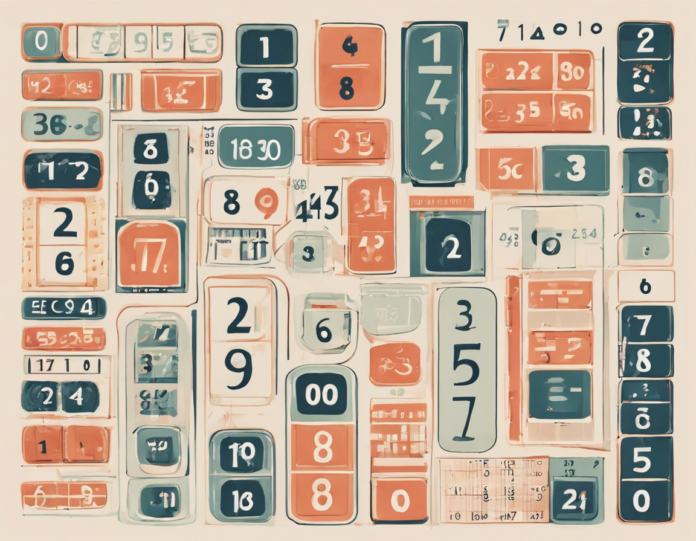Have you ever stopped to think about the significance and patterns behind two-digit numbers? While they may seem like simple combinations of a limited set of digits, there is a certain mystique surrounding these numbers that has fascinated mathematicians and scholars for centuries. In this blog post, we will delve into the world of two-digit numbers, exploring their properties, relationships, and intriguing mathematical characteristics.
Understanding Two-Digit Numbers
Let’s start by defining what two-digit numbers are. As the name suggests, two-digit numbers are integers that consist of two digits, ranging from 10 to 99. Each two-digit number can be broken down into two components: the tens digit and the ones digit. For example, in the number 42, 4 is the tens digit, and 2 is the ones digit.
Properties of Two-Digit Numbers
-
Place Value: The position of a digit within a two-digit number determines its value. The tens digit holds a value that is ten times greater than the ones digit.
-
Odd and Even Numbers: Two-digit numbers can be classified as either odd or even based on the ones digit. If the ones digit is 0, 2, 4, 6, or 8, the number is even. If the ones digit is 1, 3, 5, 7, or 9, the number is odd.
-
Factors and Multiples: Two-digit numbers have various factors and multiples. For instance, the number 24 has factors of 1, 2, 3, 4, 6, 8, 12, and 24. Meanwhile, multiples of 24 include 48, 72, and so on.
Patterns in Two-Digit Numbers
-
Palindrome Numbers: Palindrome numbers are numbers that read the same forwards and backwards. In the realm of two-digit numbers, examples include 11, 22, 33, and so on.
-
Prime Numbers: Prime numbers are numbers greater than 1 that have no divisors other than 1 and themselves. In the two-digit realm, examples include 11, 13, 17, 19, 23, 29, 31, and 37.
-
Square Numbers: Square numbers are the result of multiplying a number by itself. In the world of two-digit numbers, examples include 16, 25, 36, 49, 64, and 81.
Relationships Between Two-Digit Numbers
-
Sum and Difference: The sum of any two two-digit numbers can result in a three-digit number. However, the difference between two two-digit numbers can vary and may result in a single-digit, two-digit, or even three-digit number.
-
Multiplication and Division: When multiplying two two-digit numbers, the result can range from a two-digit number to a four-digit number. Division of two two-digit numbers can yield a quotient that ranges from a single-digit number to a three-digit number.
-
Combinations and Permutations: The world of two-digit numbers offers a multitude of combinations and permutations that can be explored in various mathematical contexts, such as in probability and combinatorics.
Curious Facts About Two-Digit Numbers
- The sum of the first 10 two-digit numbers (10 to 19) is 145.
- The product of the first 10 two-digit numbers is 3,781,425.
- The highest two-digit prime number is 97.
- The difference between the squares of consecutive two-digit numbers forms an arithmetic sequence.
- The sum of the squares of the first 10 two-digit numbers is 38,325.
Applications of Two-Digit Numbers
Two-digit numbers can be found in a wide range of applications, from everyday calculations to advanced mathematical concepts. They play a crucial role in fields such as finance, cryptography, computer science, and even gaming algorithms. Understanding the properties and relationships of two-digit numbers is essential for building a strong foundation in mathematics and problem-solving.
FAQs About Two-Digit Numbers
- What is the significance of the tens and ones digits in a two-digit number?
-
The tens digit represents the multiple of ten, while the ones digit represents the units.
-
How many two-digit palindrome numbers exist?
-
There are a total of 9 two-digit palindrome numbers, ranging from 11 to 99.
-
Can a two-digit number be both a square number and a prime number?
-
Yes, the number 11 is a two-digit square prime number (11^2 = 121, and 11 is prime).
-
Are there any two-digit numbers that are their own factors?
-
No, a number cannot be its own factor as factors are numbers that divide another number without leaving a remainder.
-
Do all two-digit numbers have both odd and even factors?
- Yes, since all two-digit numbers have a mix of odd and even factors, except for the number 11, which only has odd factors.
Exploring the realm of two-digit numbers offers a fascinating journey into the depths of mathematics, where patterns, properties, and relationships intertwine to create a rich tapestry of numerical intrigue. Whether you are a student, educator, or simply a lover of numbers, unraveling the mystery of two-digit numbers can unlock a world of mathematical wonders waiting to be discovered.









